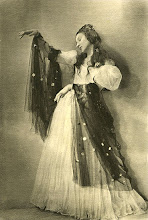In Adagietto, Mahler had composed a musical declaration of love. He sent it to Alma as a wordless proposal. She understood. It needed no text to make its meaning clear. The beginning melody is swollen with endless longing, the middle a story of their courtship, and concludes with a profound feeling of contentment. By the following summer they were married. A composer herself, Mahler's work often communicated the state of their sometimes tumultuous marriage; it seems the music spoke to her as clearly than words. She was his muse.
I first heard Mahler's Adagietto as a young girl. My mother watched the screen breathlessly as the waif-thin Ekaterina Gordeeva stepped onto a dark, pale blue ice rink and the audience held their collective breath. Her white boots looked too large, her bones too frail to hold her upright. She sailed onto the ice and the audience broke their silence, erupting into refrained applause. To the ghostly strains of Mahler's Adagietto she performed a tribute to her late husband and figure skating partner, Sergei Grinkov, for the first time stepping onto the ice-rink without him. Every movement she made was filled with pain and desperation, I wondered how she had the strength to inhale. Time passed. Wounds heal but the scars never fade.
Fifteen years later. The ice-dancing finals at the Winter Olympics in February 2010. A young Canadian couple step onto the ice, full of youth and energy. To those who remember it's impossible not to see the resemblance to the legendary, tragic Soviet couple who'd captured two gold medals in Olympics long past. It is only apparent when the music begins, the familiar strains of Mahler's Adagietto and the same choreography, this is the widow's performance, but at last performed by two. A century has not tarnished Mahler's exquisite love letter to Alma, the magic is not lost on modern audiences.

No comments:
Post a Comment